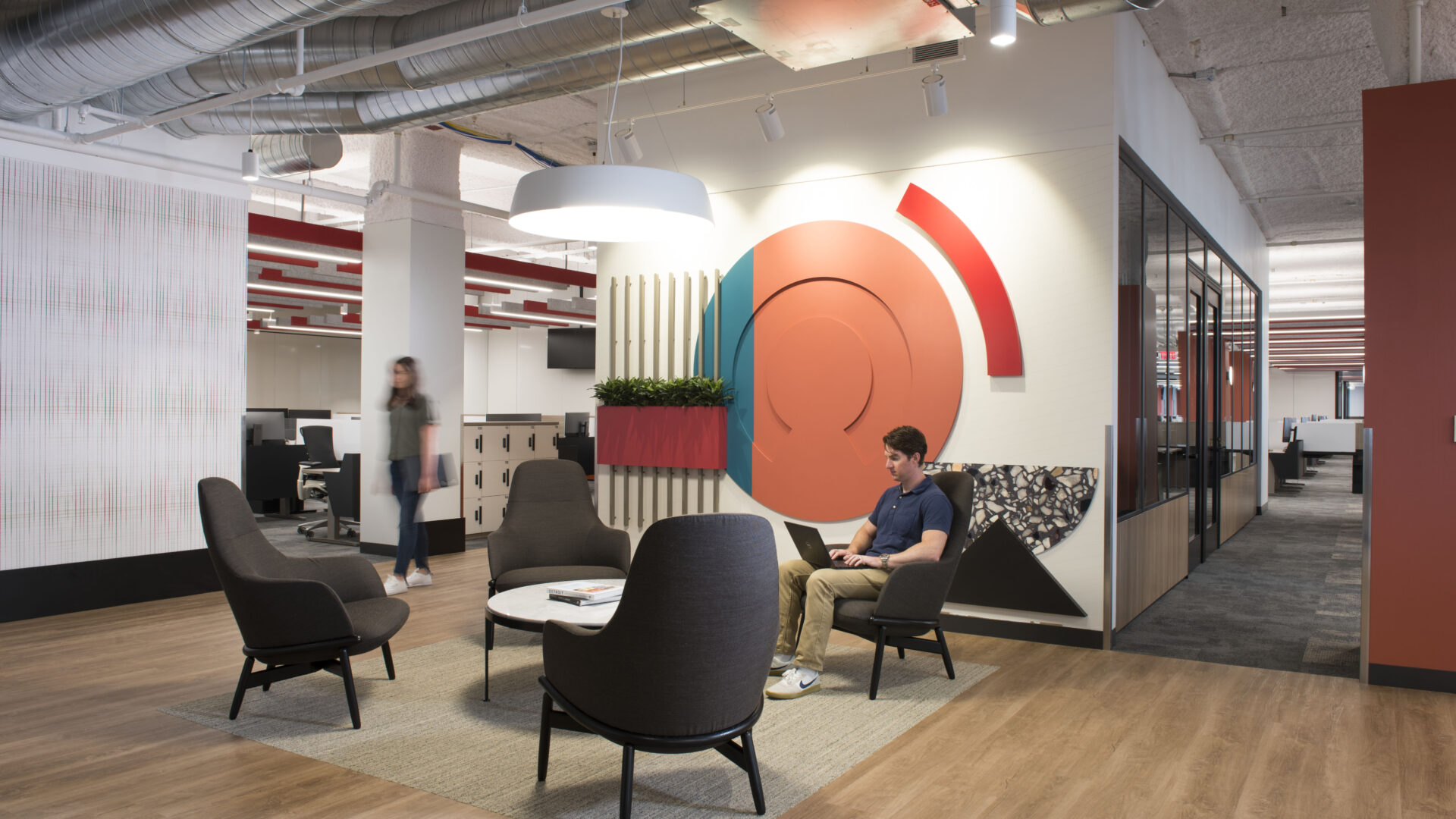Design & Dine:
A Workplace Perspective
 Read Below
Read Below
 Read Below
Read Below
One of Quicken Loans's Detroit offices, designed by Pophouse.
Design & Dine:
A Workplace Perspective
Pophouse was honored to participate in the Design and Dine series hosted by Design Core Detroit on August 27. During this virtual dialogue, our team was able to delve deeper into the shift that society has been moving through as a result of the COVID-19 pandemic. Creating purposeful, human-centric office space can have a significant impact as teams look to transition back onsite and build a new normal in light of this reset.
According to MIT, focusing on the team member experience results in 25% greater profitability, twice the innovation, and twice the customer satisfaction – truly showing that experience cannot be ignored. Remote individuals currently have some choice and autonomy with their physical surroundings and have been able to build their own environment with their preferred orientations and layouts for several months at home. This individual experience within the workspace therefore, which includes how individuals connect with the culture and brand onsite, provides a meaningful and critical tie to the organization. Approaching your workspace with a strategy and intention will ensure that team members are supported and provide a strong reason for moving back to the office.
Affordances, or what the environment offers to the individual, are a way to thoughtfully determine if the space is emphasizing the core values of your organization. During the last few months, colleagues have experienced a sense of connection and trust with each other in new ways and have learned how to adapt and discover their own affordances within their remote environments. This has caused organizations to be focused on outcomes rather than micromanagement, and business has frequently had to be re-thought as we were thrust into this new virtual world. Individuals also adjusted relationships with their colleagues as home life was much more on display than it ever was previously. These factors have contributed to a fundamental reset of our approach to work and the space needed to support that work.
Approaching your workspace with a strategy and intention will ensure that team members are supported and provide a strong reason for moving back to the office.
As we identify the types of behaviors we want to emphasize in space, the culture, and the intention of the programming, there are four affordances to reflect on: Work Setting Variability, Adaptability, Quiet Space, and Restorative Interiors.
Work Setting Variability
Individuals have had choice and autonomy in their remote settings in ways they typically did not in the traditional workplace. One thing to think about will be how people will collaborate virtually and maintain connections both onsite and while colleagues are remote. Another factor to consider is that every individual has a different personal working style and has different needs while working onsite. Being thoughtful of neurodiversity and a variety of work style preferences will help all team members discover optimal productivity and allow the space to feel inclusive. Providing choices to individuals allows them to select what fits best for them physically and mentally.
Adaptability
The world is changing quickly and the need for office space to be flexible is paramount. Planning for the short and long term can be both sustainable and cost-effective for your organization. Select desk orientations and furniture that organically allow for spacing without feeling forced or uncomfortable. Consider the full spectrum of team and role needs, repurpose assigned seating, and re-balance shared space for group work and gathering while individuals are onsite. By determining your team’s needs in advance of returning to the office, you can accommodate many possible scenarios and handle these setups in the future with ease.
Quiet Space
In the past, traditional office space lacked access to spaces that encouraged the health and well-being of the individual. Be empathetic to the needs of your workers and embed the use of these spaces in your company culture by sharing research and benefits as well as modeling these rituals directly. These spaces are personal, and the success of these amenity areas will best be realized through considering what other spaces are in close proximity to these areas. Allowing team members a chance to recenter during their time onsite supports optimal cognitive functioning and leads to better business outcomes.
Restorative Interiors
When remote or onsite individuals face a consistent barrage of distractions which can contribute to overstimulation and decreased productivity. These distractions can not only impact the focus that a team member has on their work, but over time can also cause stress, cognitive strain and sensory overload. Additionally, as our world has gone virtual, our reliance on our computers has caused an increase in screen fatigue. As people transition back to the office, consider circulation paths and high traffic areas and how individuals are situated to communal spaces. Other methods you can explore for creating restorative interiors is with biophilia – incorporating natural elements into the space and artwork. These both provide for greater mental clarity, reduction of stress and improvement of mood and increased creativity. Layers of analog and digital solutions integrated throughout the space allow individuals to move through different modes of engagement which can prove to be restorative and inspiring.
No matter what refinements you make to the space, it is important to communicate with your team and be transparent. Establish a dialogue that encourages authentic sharing to understand how people are feeling and what they could use. Share insights and research to provide awareness to your team and the why behind decisions. Developing a strategy for your company that is human-centric and data driven will set your team up for success while onsite, promoting positive business outcomes, allowing you to attract and retain talent and helping all individuals to thrive.
If you have questions about anything you have read here or would like to speak further about your company’s future workspace, please reach out to bizdev@pophouse.design
